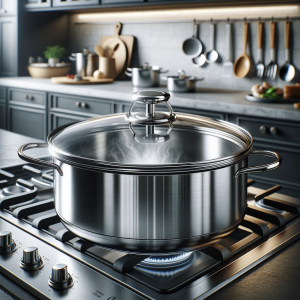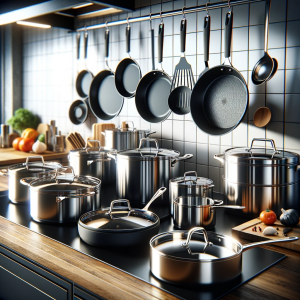In an interconnected global economy, the Tempered Glass Lid market, like many other sectors, is highly sensitive to fluctuations in the global supply chain. Recent years have witnessed significant disruptions due to events such as the COVID-19 pandemic and ongoing international trade wars. These disruptions have had a cascading effect on the supply, demand, and pricing of tempered glass lids, essential components in kitchenware and culinary applications. This extended article explores the multifaceted impacts of these global events on the Cookware Glass Lid market.
The Tempered Glass Lid Market: An Overview
Tempered glass lids are a staple in kitchens worldwide, valued for their durability, heat resistance, and transparency. These lids allow cooks to monitor their food without lifting the lid, thereby maintaining temperature and flavor. The market for these products is influenced by various factors, including manufacturing technology, raw material costs, and global trade dynamics. The advent of the COVID-19 pandemic marked a significant turning point for the Glass Cooking Lid market. The immediate effects were felt in the manufacturing sector, where lockdowns and health safety measures led to reduced workforce availability and factory shutdowns. This slowdown in production directly impacted the supply of tempered glass lids.

Raw Material Shortages and Price Volatility
The pandemic also disrupted the supply chains for raw materials essential in manufacturing tempered glass, such as silica sand, soda ash, and various oxides. The scarcity of these materials, coupled with increased demand for certain products during the pandemic, led to price volatility. These fluctuations in raw material prices were reflected in the increased costs of tempered glass lids.
Transportation and Logistic Challenges
Global transportation and logistics faced unprecedented challenges during the pandemic. Restrictions on movement, reduced cargo capacity, and increased safety protocols resulted in significant delays and higher transportation costs. These factors compounded the supply chain disruptions, leading to a shortage of tempered glass lids in various markets and delayed order fulfilment.

Impact of Trade Wars
Concurrent to the pandemic, trade tensions, particularly between major global economies, have added another layer of complexity to the tempered glass lid market.
Tariff Impositions and Cost Implications
The imposition of tariffs on imported goods and raw materials has had a significant impact on the cost structure in the tempered glass lid industry. Manufacturers faced with increased tariffs on either imported raw materials or exported finished products experienced a rise in production costs. These additional expenses often led to higher retail prices for tempered glass lids, affecting consumer demand.
Diversification of Supply Chains
In response to these trade wars, many companies in the tempered glass lid market began diversifying their supply chains. By reducing reliance on a single source or market, these companies aimed to mitigate the risks associated with geopolitical tensions and trade policy fluctuations.
Technological Advancements and Automation
In the face of these challenges, technological innovation and automation have become critical for manufacturers in the tempered glass lid market. Advancements in manufacturing technologies have enabled companies to enhance efficiency, reduce costs, and maintain quality standards. Automation has also helped in mitigating the impact of reduced workforce availability during the pandemic.
Consumer Behaviour and Market Trends
The tempered glass lid market is also influenced by changing consumer preferences and trends. During the pandemic, there was a notable increase in home cooking and baking activities, leading to a rise in demand for kitchenware, including tempered glass lids. This shift in consumer behaviour provided a market opportunity for manufacturers, despite the supply chain challenges.
Shift Towards E-commerce
The pandemic accelerated the shift towards online shopping, impacting how tempered glass lids are marketed and sold. E-commerce platforms have become crucial for manufacturers and retailers, enabling them to reach consumers despite lockdowns and physical store closures. This shift has also led to changes in marketing strategies, with a greater emphasis on digital marketing and online customer engagement.
Environmental Concerns and Sustainability
An increasing focus on environmental sustainability is shaping consumer preferences in the tempered glass lid market. Consumers are more aware of the environmental impact of their purchases, leading to a demand for products made with sustainable practices and eco-friendly materials. This trend is prompting manufacturers to adopt greener manufacturing processes and consider the lifecycle impact of their products.
The Road Ahead: Adapting to a New Normal
The tempered glass lid market, like many others, is navigating a path through these complex challenges. As the global situation continues to evolve, the industry is adapting in several ways:
- Supply Chain Resilience: Companies are building more resilient supply chains, capable of withstanding disruptions like those experienced during the pandemic and trade wars.
- Localizing Production: There is a growing trend towards localizing production to reduce dependency on international supply chains and mitigate transportation challenges.
- Innovation and Product Development: Manufacturers are investing in research and development to innovate and develop new products that meet changing consumer needs and preferences.
- Strategic Partnerships: Collaborations and partnerships are becoming more common, as companies seek to pool resources, share risks, and tap into new markets and technologies.
The tempered glass lid market has faced significant challenges in recent years, shaped by the COVID-19 pandemic, trade wars, and shifting consumer behaviours. Companies like Ningbo Berrific are adapting to these changes, emphasizing efficiency and sustainability to meet the evolving market demands. As the global situation continues to evolve, the tempered glass lid market is poised to adjust and grow, aiming for resilience and sustainability in the face of change. Despite these obstacles, the industry is showing resilience and adaptability. By embracing technological advancements, diversifying supply chains, and responding to consumer trends, the tempered glass lid market is poised to navigate the complexities of the global supply chain and emerge stronger in the post-pandemic world. The tempered glass lid market, like many others, has faced significant challenges in recent years due to global events. However, the industry’s response in terms of adaptation and innovation provides insights into navigating these unprecedented times.
Post time: Jan-23-2024


